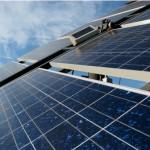New solar cell with 34.5% conversion efficiency developed
 A solar cell developed by engineers at the University of New South Wales (UNSW) has broken the record for sunlight-to-electricity conversion efficiency at 34.5%.
A solar cell developed by engineers at the University of New South Wales (UNSW) has broken the record for sunlight-to-electricity conversion efficiency at 34.5%.
The new cell is a huge jump from the previous record of 24%efficiencywhich was achieved by Alta Devices, and the result has been confirmed by the US National Renewable Energy Laboratory. Not only this, but the new cell works on a much smaller surface area. The old record holder worked on a large 800-cm2 surface area, whilst the result achieved by the UNSW was reached with a 28 cm2 mini-module.
In a recent news release the UNSW outlined how the cell works: ‘using a 28-cm2 four-junction mini-module – embedded in a prism – that extracts the maximum energy from sunlight. It does this by splitting the incoming rays into four bands, using a hybrid four-junction receiver to squeeze even more electricity from each beam of sunlight.’
The new cell was created by Dr Mark Keevers and Professor Martin Green of UNSW’s Australian Centre for Advanced Photovoltaics, who have commented on the development:
“This encouraging result shows that there are still advances to come in photovoltaics research to make solar cells even more efficient,” said Keevers. “Extracting more energy from every beam of sunlight is critical to reducing the cost of electricity generated by solar cells as it lowers the investment needed, and delivering payback faster.”
“What’s remarkable is that this level of efficiency had not been expected for many years,” commented Green “A recent study by Germany’s Agora Energiewende think tank set an aggressive target of 35% efficiency by 2050 for a module that uses unconcentrated sunlight, such as the standard ones on family homes.”














